Getting a chicken coop ready for winter isn't as big a deal as you think. For instance 99% of the time your coop isn't going to need a heater. With some insulation, good ventilation and a windbreak your chickens will be comfortable even through a Canadian winter.
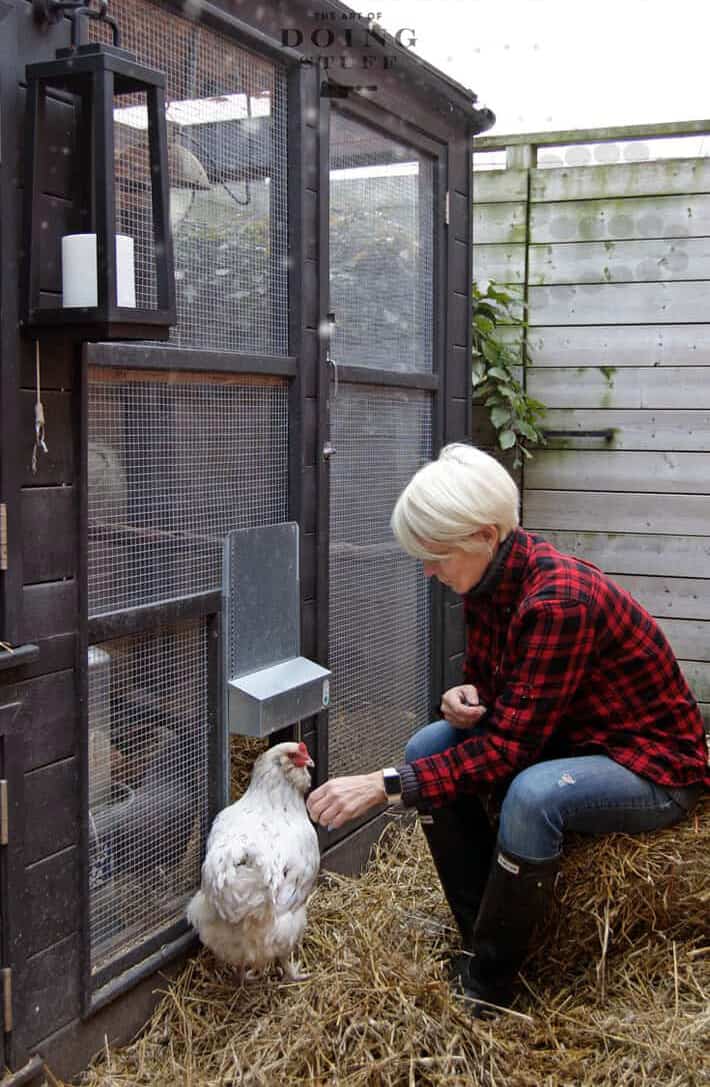
Notice the automatic coop door? It is one of the BEST accessories you can equip your coop with.
Read my post on how to install an automatic coop door and which one I use.
You may be thinking to yourself, Hey, I don't own chickens so I don't need to winterize a chicken coop. And you would be right. Feel free to skip this post and instead read about how cheese was invented and how to make your own cheese serving board. I will wonder about your judgement if you do skip this post, but truth be told, I was already wondering about you.
the original chicks.

I've had many years of learning about chickens gaining the most valuable information: the kind you get from experience. Not books, the Internet or word of mouth teaches you like experience does.
One of the things I was most scared of that first year was winter.
Now in my 13th year of owning chickens I no longer worry that the chickens will freeze to death.
Back in my first year I hadn't considered the fact that chickens are covered in feathers and down and all the other birds in the wild seem to manage to survive without me running out with heaters and sweaters for them.
The truth is, the heat of summer is far more dangerous to your chickens than cold.
Having said that, there are still a few things you need to do to get your coop ready for winter if you live in a colder climate.
Table of Contents
How to Winterize a Chicken Coop
- Clean out the entire coop. This is especially important if you use the deep litter method like I do. Scrape the ladders, walls and floor of any caked on poop. At this moment, those of you who don't own chickens but decided to read this post anyway are now saying "See? This is exactly why I don't want chickens".
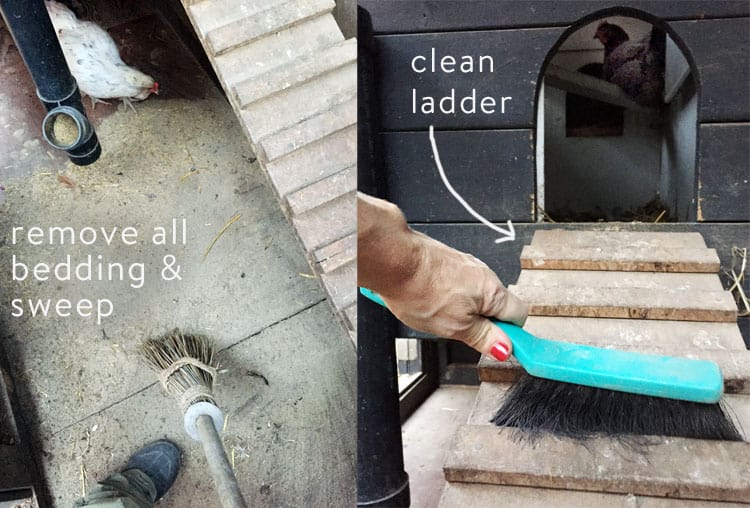
2. Add in an extra-thick layer of bedding. I use straw because each individual piece of straw is filled with air which acts as great insulation. I start with at least 6" of bedding in the run and 8" in the roosting area at the beginning of the winter season.
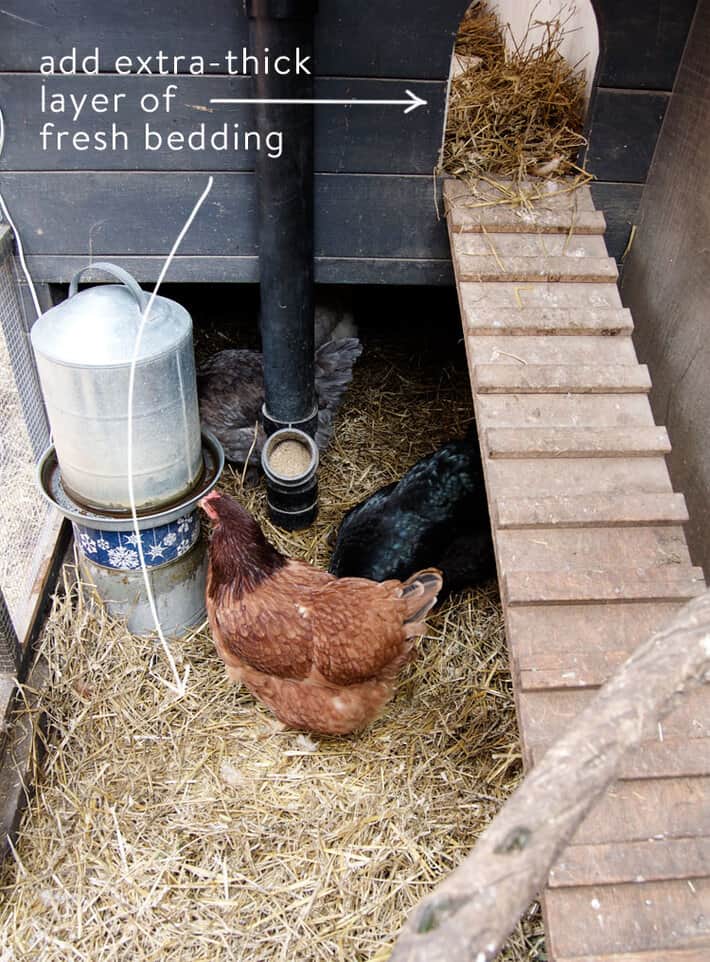
3. Block out the wind and snow if you have an open run like I do. Half of my coop is made of hardware cloth which doesn't provide much of a barrier in the middle of a raging winter blizzard. For the first few years I tacked up plastic sheeting like this to block the wind and snow, but then invested in plexiglass. I had pieces cut to size to fit in each of the coop openings that needed to be filled.
If you do either of these things make sure you leave adequate ventilation at the top of the coop. Ventilation is very VERY important. In fact, a poorly ventilated coop will also kill your chickens more quickly than the cold will. Without adequate ventilation the coop will become humid which can cause frostbite in cold weather plus the air will be toxic with ammonia from all the poop. So ventilate. Got it?
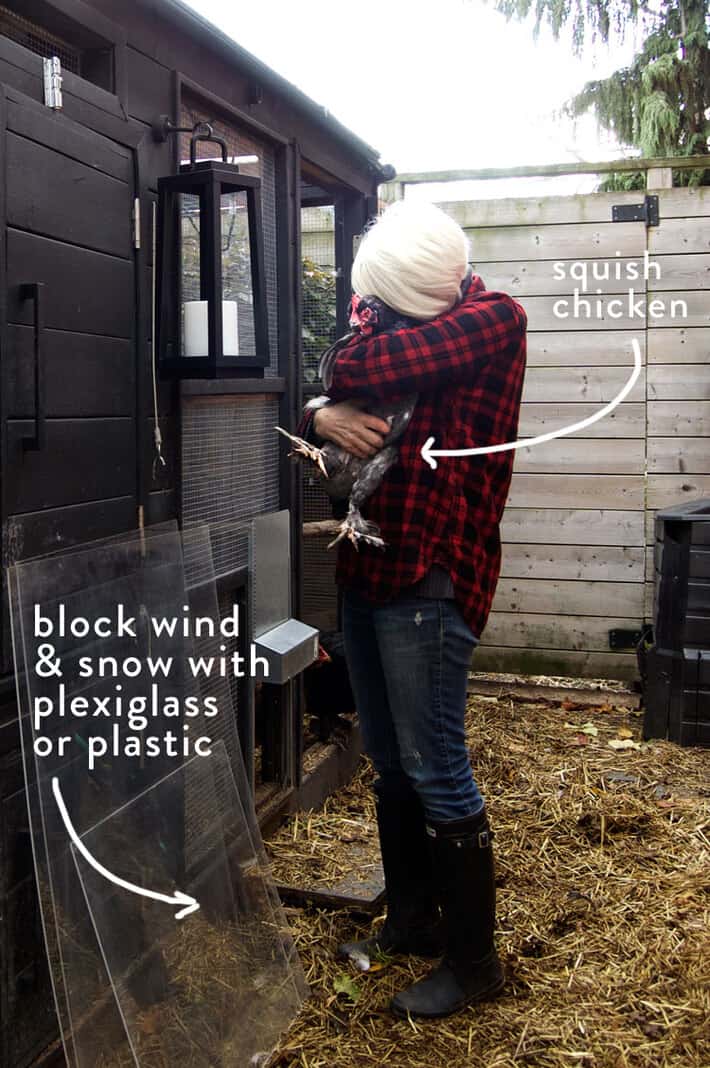
That's Mabel. She's 9 years old now. She still doesn't like being squished.
4. Keep your water thawed. You can buy a variety of different heated water systems for your coop to keep it from freezing all winter, but the most economical way is to DIY your own. You can either add small outdoor Christmas lights or install an actual low watt bulb into a metal cookie tin. If you're in a pinch and don't have a metal cookie tin handy, you can go the even easier route using this method.
I have a whole tutorial on installing the lightbulb in the cookie tin here. Set your regular metal waterer on top and the heat from the lights is enough to keep the water from freezing.

5. Put your lights on a timer if you want your hens to lay in the winter. A chicken is triggered into laying eggs by the length of the day. They need 14-16 hours of light to regularly lay eggs. Anything under that (like the 9 or 10 hours we typically get in winter) and they will spend all those extra hours sleeping as opposed to egg laying.
Supplemental lighting is a bit controversial with some owners preferring their hens follow the course of nature by getting the winter months off of laying. If you do choose to use a light to help with continued laying set it to come on prior to dawn. If dawn is 8 a.m. and dusk is 6 p.m. (10 hours) you need to set your timer to come on at 4 a.m. to get regular egg production.
Would you like to save this stuff?
I don't do this during the shortest days of winter, allowing the chickens to rest. I do however use supplemental lighting in the fall and spring.
6. Heat the coop? That's another controversial subject among chicken owners. I was convinced that chickens needed to be toasty warm when I first got my birds, but quickly realized that heat wasn't going to make the hens more comfortable, it was going to make ME more comfortable.
Chickens are covered in feathers. They're fine in the cold. Don't fret it. Keep the wind and snow out of their coop and they'll be fine. I *do* have a safe, ceramic, wall mount heater in my coop for nights that get exceedingly cold to prevent frostbite on any areas of the chicken that aren't covered in feathers like their feet, combs and wattles.
Last year I didn't turn it on at all.
Any nights that will be below 4 Fahrenheit or -15 Celsius, I will turn the heater on to raise the temperature by a just a few degrees.
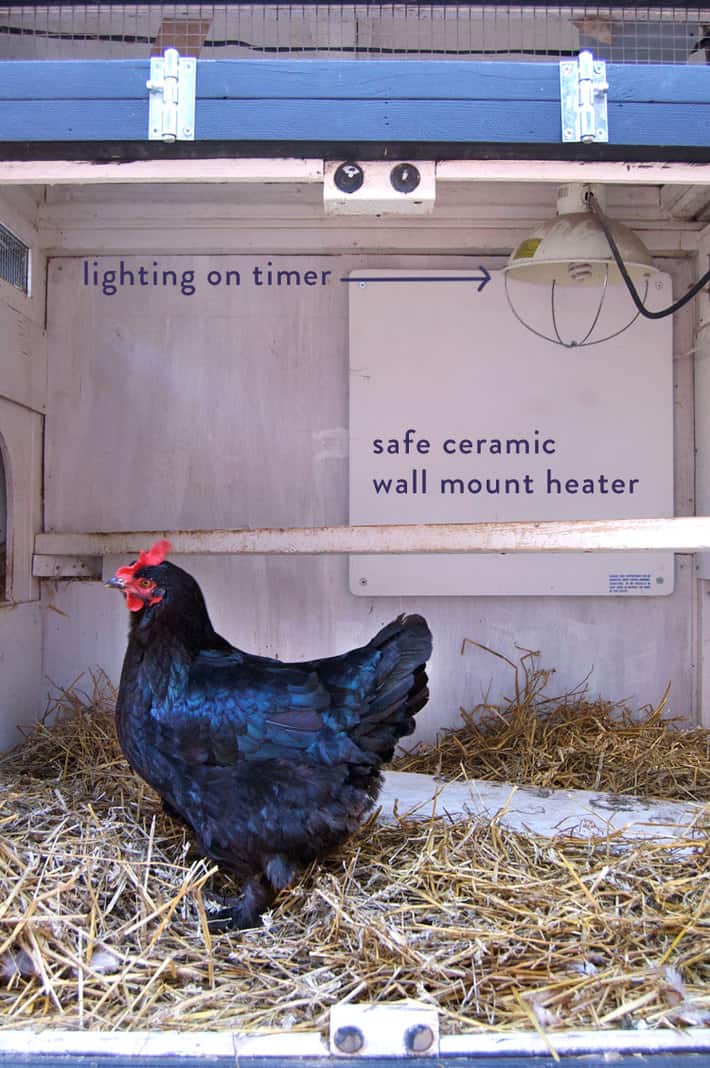
7. Insulate the coop.
Insulating your coop is a smart idea. I have placed styrofoam insulation between the studs of the ceiling of my coop to help hold heat in at the top.
Straw also acts as a great insulator, and using it on the floors will insulate the coop from the cold ground.

8. Number of chickens per square foot
The MOST important part of keeping chickens in winter is the number of chickens you have per square foot. More chickens = more heat = more moisture. If the balance is off between your chickens and square footage, the coop will either be colder than you want, or higher in humidity than you want. (a lot of chickens in a small space means they're giving off a lot of moisture with breath and poop. The high humidity in turn makes the chickens colder, more prone to frostbite and susceptible to respiratory distress.
Winterizing the flock
Now that the coop is ready for winter you need to winterize your hens.
Shorter days prompt moulting in chickens, where the hens lose their feathers and grow new ones. They do this to make sure they have their own natural layer of insulation that's in perfect condition for the winter. Moulting takes a lot of energy from your girls, so any extra energy they have goes into moulting as opposed to laying eggs.
To winterize your flock make sure they get extra scratch before bed to help keep them warm throughout the night.
Shorter days also trigger your hen to stop laying eggs so they can use their extra energy in the winter for keeping warm and resting up.
How to get chickens to lay in the winter.
Chickens naturally stop or slow down with their laying through fall and winter. They don't make the decision to do this, it's a natural process that begins when the days start to get shorter.
To help prompt your hens to lay throughout the winter there are 3 things you can do:
- Install lighting in your coop. (Hens need a minimum of 14 hours of light a day to lay eggs)
- Add *minimal* heating. (If hens are busy using their energy to keep warm they won't have enough left over to lay eggs)
- Feed extra scratch before bed. (Extra fatty feed gives them the energy to keep warm & well rested)
How many square feet do you need per chicken?
4 square feet per 1 chicken (inside of coop)
So for a coop area that is 6x6 the ideal number of hens is 9. (6x6 = 36 square feet of space. 36 sq. feet of space / 4 sq. feet of space needed per chicken = 9)
If you do all these things you can feel confident that your chickens will make it through the winter comfortably. I wonder what kind of care goats need in the winter?
And would they like kickboxing?
→Follow me on Instagram where I often make a fool of myself←




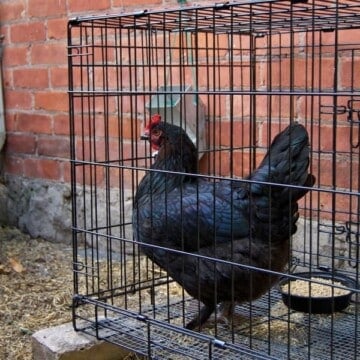

Deb
Everything mentioned here was so very helpful. This will be my first winter with my girls. Up here in Atlantic, Canada some days can get pretty frigid. May I ask where you purchased your ceramic heater?
Karen
Hi Deb! I got it at Home Depot, but they're fairly widely available. ~ karen!
Rebecca L Hoppe
Your story is eerily similar to mine. I think the goats are coming in the spring... And while we're at it, let's make them dairy goats!
Jackie
Question about roofing/ventilation:
Hi Karen,
We are building our coop now and in New England so I am worried about harsh winters! We were planning to do the rolled tin roof or some similar kind of panels. My question is: would you recommend plywood then putting the roofing OR just the panels and those rivets act as ventilation holes up high? We have a window in for warmer days that I’ll seal up for the winter. What do you think?
Karen
Hi Jackie! Do plywood with a layer of styrofoam insulation and then another layer of plywood (or something similar to stop the insulation from dropping down on the chicken's heads. This will help a LOT with keeping the coop cool in summer and warm in winter. Do venting similar to mine that runs along the top of the coop walls. ~ karen!
nedra
For a cheap option to winterize my coop/barn, I use what I have, feed bags. My cup runneth over with horse, goat and chicken feed bags. I staple them over the windows each fall. My husband gets a chuckle at my red neck fix and my chicks do not have a draft. I am in North Carolina so I rarely get a long deep freeze. My girls go outside every day unless the cold is bitter. I would love to share a pic of my winter ready barn with you.
Karen
Hi Nedra. You can send pics of your redneck chicken coop to karen@theartofdoingstuff.com :) ~ karen!
Kari Flint
Thanks for the info. I opted for a mini Oil-filled radiant heater that I only use when the temp drops to single digits. I give my girls a break in the winter - no extra light to encourage egg production. I plan to add plastic to the outside of the windows to prevent drafts (I have second hand aluminum framed windows) and I will put up an extra board to try to prevent blowing snow/draft into the exterior door. I use a heated dog watering bowl that I put outside and check/fill daily. I opted for pine shavings mostly because it is easiest to keep clean and doesn't block the door in and out of the coop. My hubby wouldn't put in ventilation last winter because he didn't want a draft -- I took care of it myself because there was frost on the inside of the windows -- solved the issue and the over-powering ammonia odor too. I added an area in the run that allows for then to be outside out of the draft and is covered so they will get some exercise -- I added straw to the run to cut down on the mud drug into the coop on the wetter days before the freeze solved that issue. I think I am more prepared this year. I am very thankful I didn't lose any birds last year -- they do NOT have a rooster this year -- he was mean and I evicted him to live elsewhere -- just my 8 girls this year <3.
Karen
It sounds like you've done everything right! Good for you for adding ventilation. Lack of ventilation will KILL them! Good job! ~ karen
Adrienne
Hi Karen! Thanks for all the information! I love checking your blog first when searching for answers or ideas for my girls. I have a quick question about ventilation vs. winter elements protection. My coop and run are located in a larger corner (?) made by one wall of my garage and one wall of the main house, which I chose for its lack of wind. The run has a full shingled wooden roof. My question is, have you every used (or known anyone that used) heavy canvas to cover the hardware cloth as opposed to plexiglass/plastic? I don't think my coop/run will bear the full brunt of a storm and thought the benefits of having a semi breathable material might be worth trying. Wanted to check and see if you had any experience or knew of some reason why I shouldn't! Thanks!
Karen
Hi Adrienne! The main reason I wouldn't use something like canvas is because it'll get wet and heavy. The other reason is because chickens need light to lay eggs. Also just to be generally happy, so if putting up canvas would prevent t hem from having light all winter I probably wouldn't do it. For the first few years I just used construction grade rolls of plastic and stapled it up. All you're doing is preventing wind from coming in the coop while leaving ventilation at the top. I know canvas is technically breathable but it's not breathable enough that you could cover the whole walls and expect it to act as ventilation. Hope that helps! ~ karen
Courtney
I love the plexiglass idea! How do you attach yours to be easily removed for spring?
Karen
Hi Courtney! Every year I say I'm going to devise a really easy and smart way to hold the plexiglass but every year I run out of time, lol. I basically just hold it into place with finishing nails. They don't go through the plexiglass, they just go into the wood frame of the coop to stop the plexiglass from falling out. Much the same way the back of a picture frame would be. ~ karen!
jax jc
id find aluminum track u shaped thats just a bit wider than the plexiglass an attach it so i could slide in the plexiglass panels when needed
Chelsea
A little late to post, but I love this coop.
I am thinking of taking this design and modifying it for my first duck coop. Thanks for sharing all the photographs.
Chelsea
Karen
No problem Chelsea! Good luck. ~ karen1
Asia
Hi Karen,
Your information has been very helpful and reaffirmed some methods I have read about and what we prefer for our chickens. This is our first year with our 13 ladies and rooster for the winter. We have a metal shed 10x14 , it’s is sectioned off. The dividing wall the chickens are is 10x10 area with the one wall and ceiling insulated. Wondering what type of ventilation you would recommend as it has a peaked roof and we are doing the deep litter method? Temp in winter can reach -20c to -30c in the depth of winter.
We want to make sure they are comfortable with no draft but great ventilation. Summer and fall we keep coop open all day and close it at night so we have never needed the ventilation before.
Thank you for any advice.
Karen
Hi Asia. Do you have any windows in the coop? If not, you should install a roof vent. The coop just needs a way for the humidity to escape. ~ karen!
Sharon
Can I ask what is that little door by the big door and where did you get it? I want something like that on our run.
Karen
Hi Sharon. It's an automatic coop door. There are a few on the market. The one I got is an "Ador" coop door from AdoreStore. It's expensive but works great. I love it and have never had a single issue with it. Wait. I lie, lol. Last week for the first time ever it didn't close at night because there was snow built up in the rails of it. But that's never happened before. ~ karen!
Mary Casey
Karen,
Your info on chickens - (and many other things😃) has been soooo helpful to me
Over the years. The one issue I seem to be dealing with over and over is mites. I remember you said you dusted with something very strong- that worked for you. I probably can't get the product you used- the US products are different than CA. But do you know the main ingredient that was in the product you used? Permethrin? Pyrethrin? Carbaryl? And how often did you apply until they were gone? I know I need to continue things for maintenance, but if I could just get them out first, I can do that. Thanks, and on winterizing, is your coop insulated? I am in process of building a new coop and thinking of adding some.
Thanks!
worked
Melissa Keyser
Despite having chickens my whole life, the whole ventilation thing confuses me. I mean, I get why isn't needed, but how do you create ventilation but NOT drafts? Being in a temperate climate, I just leave everything open all the time, so I don't have a problem, but how do you cover your screens with the plexi but still have ventilation?
There is a possibility we'll be moving to a snowy area in the next few years, so if I start studying up on this now, maybe I'll have it understood by the time I actually need it....
Karen
If you look along the top are of the actual "roosting" area (with the large double doors up top) there are open areas with hardware cloth. These are open all winter. They allow venting but don't put a draft directly on the chickens because they vents are up high. If there's a HUGE winter storm with wind and snow then I cover them with plexiglass for the night so the girls don't get snowed on. ~ karen!
Angie
Great article. Thank you!
Karen
You're welcome Angie! ~ karen
Amy
Thank you! I've been looking everywhere to find out what temp to turn on the heater in the coop. Finally found an actual temperature recommendation here!
Karen
You're welcome Amy. :) That's my recommendation. Others turn it on when it's colder but this is the temp. I'm happy with. :) ~ karen!
Sarah
Good evening Karen!! I've been holding back on commenting because I didn't want to look like a complete lunatic but I'm not for faking anyway..😏. I would absolutely love to squeeze a chicken!! Yours are gorgeous and beautiful and might take my eye out but it's a risk I'm willing to take to hug a chicken. I'll wear eye protection!! By the way, you have the funniest writing style ever and I have to read your posts everyday to cheer me up!! Thank you so much for sharing your life, recipes and chickens and maybe one day I'll get to squeeze one and pet it in person and not in my imagination!!
Karen
Life's too short for holding back on commenting, chicken hugging or anything else! ~ karen
Sarah
Yay!!! You responded!! I'll bravely comment to my hearts content and thank you for responding back!! I feel like a rock star!! You made my heart flutter!!! I can't wait to squeeze a chicken!! God bless Karen and I can't wait for the ensuing hilarity!
Nancy Blue Moon
You are the best chicken mama ever...you chicken squisher you...lol
Sarah
I can’t believe I’m going here butttttt... the white chicken in the picture with the splash coloring and is bearded/muffed... what color eggs does she lay?! I have her twin and still waiting on egg color! Sold to me as an Olive Egger but someone else said they think she’s a blue laying ameraucana so I have my fingers crossed!!!!!!
Karen
Hi Sarah! My Splash chicken is an Olive Egger. Yours does look like an Ameraucana because of the leg colour and the fact that she has no feathers on her feet (which she would get from the Marans) but not all Olive Eggers have feathered feet. If you know what her parents were and what their parents were you'll have an idea of what you should get from her. Mine is an Olive Egger mother and a Splash Ameraucana father (if I remember correctly). BUT Olive Eggers aren't guaranteed to lay olive eggs, it's just that the likelihood is much greater. :) You could still get dark brown eggs for instance. But if you bought her as an Olive Egger chances are you'll get olive eggs. If it was a first generation cross (F1) (Ameraucana w/ Marans as opposed to Olive Egger w/ Marans you're less likely to get an olive egg and if you do it will be a lighter olive than you would get with a second generation olive egger. :) ~ karen!
Thera
Has it really been 8 years? I remember ohhhing and ahhhing over that post and I am still jealous and still want chickens! May your chickens haven a wonderful warm dry winter!
Karen
Thanks Thera. :) ~ karen!
Hannah
The only thing I didn't like is how '-15C' is 'the most frigid weather'. PLEASE. -15C is a pleasant day. Our chickens live in a wooden shed (insulated) that is winter-round heated with a heat lamp. That's sucker's on steady from October-March or else we get dead/maimed chickens.
I am very envious of places where it gets warmer than -20 during the winter, and it's probably a lot easier to raise chickens in that kind of environment. Trying to keep chickens from killing themselves in -40C is a day-long challenge. They will huddle in a giant group under the heat lamp and the ones in the middle get heatstroke and the ones on the outside freeze their combs off.
Paula
How many chickens do you have now? How long is their roosting bar?
Karen
Just 4. :) I'm not sure how long it is. Long enough for 4 chickens anyway, lol. ~ karen!
Paula
Thanks Karen, I was trying to gauge how much space you give each one and then I was going to compare it to mine to make sure I was giving mine enough room. As you know, if you read on the Internet, there are 15 different answers.
Karen
Oh! They need enough room to have several inches between them in the summer when it's hot and if they don't get along for whatever reason. I'm guessing you could get away with a foot per bird, plus another foot or so for wiggle room. Total guess though. ~ karen!
Christine Warren
I solved my heat problem with a heater made of a Terra cotta pot with saucer and a light socket kit. I expanded the hole in the bottom of the pot and put the light socket in. Using a low wattage bulb I set the pot with light inside on it's saucer (no contact with straw or coop that way) and leave that in the center of the chicken's"living room." It's never so hot that I can't hold my hand on it, but it radiates heat and takes the chill off...and looks cute too!
Karen
Good idea! ~ karen